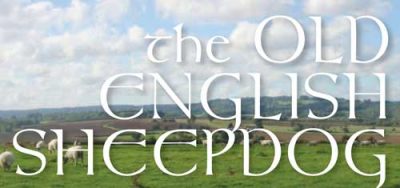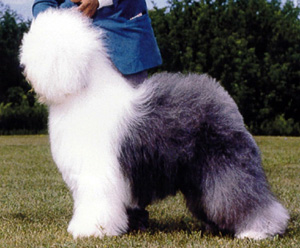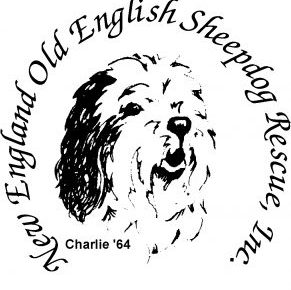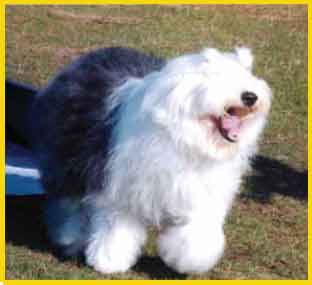Reprinted with permission - Canine Review - August 2012 issue

The Old English Sheepdog (OES), or "Bobtail," originated over 200 years ago in England's West Country, and was first known only as "the Shepherd's Dog." They are thought to have descended from a variety of European herding breeds, and were developed by sheep farmers to herd and drive sheep to market. Proof of the dog's occupation was a docked tail, which made him exempt from the English dog tax as a working dog. The tradition of tail docking remains in many countries, and is the origin of the breed's Bobtail nickname.
The Drover's Best Friend
To describe the characteristics, temperament and capacity for training of the Old English Sheepdog, one must first understand the trade of droving which dates back to ancient times in Britain. A drover was described as a licensed individual of outstanding character, responsible for taking vast herds of animals numbering from in the hundreds to the thousands—cattle, sheep, pigs, turkeys and geese—to market, and collecting money for the owners of the animals. The drover's route took days, as some roads were over a hundred miles long. A hard-working, intelligent herding dog was essential, but not one that would overwork the herds and the flocks, as the animals had to arrive safely and in good weight to receive the best market value.
The drover's dog had to adapt to constant shifts in environment—moving from the farm to the travel route to the marketplace—as well as to changing weather. Life on the road was harsh, so the dog had to have a weatherproof coat. This special dog needed to be a steady and enthusiastic worker, tireless, loyal and watchful. He had to protect his flocks from predators, yet control the herds without viciousness, and have an innate ability to sense his master's wishes.
A collection of historical stories compiled by Ray Owen in The Very Old English Sheepdog (2000), includes many remarkable accounts of drovers and their dogs. When the drovers were finished the trek to market, they would often send their sheepdogs home, while the drovers remained at market. These highly intelligent Bobtails would make the return trip by themselves, stopping at taverns where they would be fed and watered on the drover's account. On the next trip, the drover would settle his sheepdogs' "tab." Some dogs were even entrusted to take the purse of money home to the owner of the herd. Many a drover would advertise his route, picking up new stock along the way, adding to the workload and responsibilities of the dog.
The breed was first shown at a conformation dog show in England in 1865, and by 1873, the OES was given a separate breed classification with the Kennel Club, and three OES competitors exhibited at the Curzon Hall Show in Birmingham, England.
The first registrations were recorded in 1877. In 1888, there was an entry of 20 and by 1899, 50 OES were entered at a Kennel Club show. The Old English Sheepdog Club (of England) was founded in 1888 and the breed was officially recognized by AKC in the same year.
Square, Strong and Healthy
The breed standard drawn up in late 19th-century England (1885) outlined the desirable conformation and temperament traits. This standard was adopted in Canada when OES were first imported to this country and has changed somewhat over the years. Historical records list two OES among CKC registrations for 1902-03.
Today, the OES retains the qualities valued by both the first exhibitors-breeders and drovers. The physical attributes remain the same and the herding instinct is intact. This squarely built dog has a thickset, muscular body that provides both strength and agility. One distinguishing breed characteristic is an unusual topline, which slopes from loin to withers, as well as the long, harsh, shaggy coat which comes in shades of grey, grizzle, blue or blue merle, with or without white markings. The dog is generally white on the head and shoulders with patches of grey, and grey from the shoulder back with occasional white splashes. Any shade of brown or fawn is unacceptable. His unique double coat consists of a soft undercoat and a harsh water- and dirt-repellent outer coat made up of "guard hairs." The coat is woolly, and when wet, smells a bit like a damp wool sweater.
Most popular breeds have an oily hair coat and hair that is shed sticks to clothes and furniture. Much to the surprise of prospective pet owners, the OES does not shed, and elicits far fewer allergic reactions than most breeds. If kept long, the double coat requires regular line brushing to keep it healthy and free of matting. Regular trips to the groomer can ensure the coat is kept short and easy to care for, or pet owners can easily learn to groom with the guidance of a breeder or professional groomer. Most dogs enjoy being groomed and look forward to their turn on the table.
Popular mythology claims that if you cut the "shaggy bangs" exposing his eyes, the Old English will go blind. Rubbish! An innately watchful creature, this dog likes to see what is going on just as much as we do. For that reason, you will often see them with hair pulled back and fastened with an elastic or barrette.
According to the breed standard, the size is 22 inches and upwards for dogs, slightly less for bitches. However, today's dogs are generally larger. The head should be square with plenty of room for brain power and well-covered with shaggy hair. Eyes may be dark brown, or any shade of blue. Occasionally, a dog will have one eye of each colour; this is also acceptable. The nose should be large and black. Puppies are frequently born with pink noses which gradually turn black. Teeth are strong, large and level in opposition.
The CKC standard describes the OES as a strong and compact specimen "of great symmetry, practically the same measurement from shoulder to stern as in height, absolutely free of legginess, very elastic in his gallop, but in walking or trotting he has a characteristic ambling movement ...." His neck should be fairly long and arched gracefully, with shoulders well laid-back for reaching, and quick turning capacity. The hind should be round and muscular and the hocks should be well let-down and perpendicular to the ground.
Their lifespan averages between 10 and 12 years, and certainly many have lived longer. They remain fun-loving puppies in attitude throughout their lives. There are no aliments which are unique to them; rather they face the same health concerns which afflict all large breeds. Hip dysplasia, thyroid disease and eye problems are the primary health concerns. Occurring far less frequently are cerebella ataxia, gastric torsion and deafness. Reputable breeders will have health tests done on hips, eyes and hearing.
Living with "The Shaggy Dog"
The breed is blessed with a cornucopia of wonderful traits: amiable, gentle, jolly, even-tempered, adaptable, friendly, faithful, protective, alert and intelligent. While originally bred to be a hardy working dog capable of independent actions, often without supervision for extended periods, OES are in every respect a superb companion dog and are wonderful with children, although perhaps a bit rambunctious during puppyhood for very young children. The modern Old English Sheepdog never strays far from his owner or home. He always watches and makes every effort to anticipate his master's next move. Many who have owned the breed say they exhibit a sense of humour and are widely claimed as the clowns of the dog world. Both males and females are equally affectionate.
Easily motivated by praise, their behaviour can be reinforced with interesting challenges. OES love agility, scent hurdles, herding trials, and obedience's open and utility exercises (although they quickly become bored with the precision work of heeling). They are enthusiastic to learn new activities, and enjoy nothing better than spending time outdoors with their owners. Once taught their place in the family structure and given adequate guidance, the Old English is a valued, affectionate and self-regulating family member, with a predictable and reliable temperament.
Judging the OES: Look Beyond the Coat
by Terry Carter
There are few breeds whose conformation, good or bad, is as well-hidden as that of the OES. First, the heavy, thick coat obscures the dog underneath; secondly, "artistic" grooming can enhance a less-than-ideal feature, or less skillful grooming can make good qualities very hard to find. Because of this, it is essential that judges of our breed learn to properly use their hands for assessing the dog.
In general appearance, the OES should look strong, compact and square, as called for in the CKC standard. The AKC standard also emphasizes a square dog: "Length, measured from the point of shoulder to point of ischium (tuberosity), practically the same as height." His length of leg should be equal to his depth of body. Be aware that excessive trimming over the hind quarters can make a longish dog look shorter than he is, and a heavy coat in front of the forechest and behind the rear can make a dog that is in fact square look long. You must put your hands into the coat to find out the true structure of the dog.
The head is definitely one area where you will not truly know what it is like until you go over it with your hands. The stop should be well-defined (please note this is missing in the Canadian standard). Put your thumb at the bottom of the stop and spread your hand over the backskull. Your hand should barely extend to the occiput in an average size male and the width should be approximately the same. The muzzle should be about two-thirds the length of the backskull. The British changed their standard to equal length nearly a decade ago and in the opinion of many, truncation (bluntly squared off) of the muzzle is lost.
Eyes can be dark brown or blue and a split eye (blue-and-brown in the same eye) is sometimes seen. Our standard does not call for pigmentation of the eye rims and although it is more attractive, this should not enter your decision-making.
The neck is "fairly long, arched gracefully" and blends smoothly into nice, clean, sloping shoulders. Again, you must run your hand down the neck and over the shoulder as the neck of a heavily coated dog will not be easily seen and the neck of one that is quite stripped will appear longer than it is.
Your hand should run along the topline, discovering a gentle rise to the loin which should be short, thick, and muscular. The rear is muscular and well-rounded. The ribs are well-sprung but not barrel-chested, which usually leads to coarse shoulders.
The forelegs are dead straight and well-boned with a round tight foot. The OES is not a wide-chested breed and he should be wider in the rear. His hocks should be "well-let-down" with no cow hocks or barrel hocks. Again, you must run your hands down the legs.
Puppies are born black and gradually change to a harsh grey coat as adults. An adult coat should feel hard and have a break to it. There is a dense, soft undercoat. Show dogs are washed very frequently which tends to soften the coat, so feel for texture in the grey hair. The hams are a good place to check coat texture. Do not expect a harsh coat in a puppy but in older puppies or adolescents, separate the coat and you should see the beginnings of guard hair coming in. You can also do this if you are querying whether the dog presented to you has the coat he was born with or heavily enhanced.
In some cases, OES grooming has become very extreme and looks cartoonish. I do not feel OES need to have their coat backcombed. A good coat will be thick enough to stand out from the body and some judges will ask for backcombing to be removed before judging. The coat on the head may need backcombing so that the dog can see properly, as we have bred more coat in than they need. Also the head coat is washed so often that it will probably lay flat if not helped.
Markings should not influence your decision and white splashes in the body or dark markings on the head or in the white are of no consequence. Adolescent dogs often go through very washed-out coat stages or sometimes turn brownish as the puppy coat dies. Please check the roots to see what the colour is before penalizing for a brown coat. An adult should definitely have a grey coat.
"Soundness should be considered of greatest importance," says our standard. However, I think exhibitors sometimes interpret this to mean the fastest is the best. The Old English should have a nice, easy, ground-covering gait when moved at a trot. Legs flailing in all directions are not correct. When moved at slower speeds, they will naturally amble or pace. This is correct and it is the gait used when they move stock; they can go for miles at this speed and when used as drovers' dogs, they did. The OES roll is more easily seen at a slower speed. This roll is in the rear not the front. Movement in the show ring is universally judged at a trot but keep in mind that these other movements are typical of our breed and some judges will move them at two speeds. When moving OES away from you, watch their feet as it is easy to be deceived by hair. It takes a while to learn to judge movement in coated dogs and any time spent learning ringside is worthwhile.
I would hope that judges will enjoy judging our breed and not view it as a large puffball but as a credible member of the herding group.









